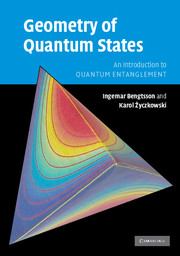Book contents
- Frontmatter
- Contents
- Preface
- 1 Convexity, colours and statistics
- 2 Geometry of probability distributions
- 3 Much ado about spheres
- 4 Complex projective spaces
- 5 Outline of quantum mechanics
- 6 Coherent states and group actions
- 7 The stellar representation
- 8 The space of density matrices
- 9 Purification of mixed quantum states
- 10 Quantum operations
- 11 Duality: maps versus states
- 12 Density matrices and entropies
- 13 Distinguishability measures
- 14 Monotone metrics and measures
- 15 Quantum entanglement
- Epilogue
- Appendix 1 Basic notions of differential geometry
- Appendix 2 Basic notions of group theory
- Appendix 3 Geometry: do it yourself
- Appendix 4 Hints and answers to the exercises
- References
- Index
Epilogue
Published online by Cambridge University Press: 27 August 2009
- Frontmatter
- Contents
- Preface
- 1 Convexity, colours and statistics
- 2 Geometry of probability distributions
- 3 Much ado about spheres
- 4 Complex projective spaces
- 5 Outline of quantum mechanics
- 6 Coherent states and group actions
- 7 The stellar representation
- 8 The space of density matrices
- 9 Purification of mixed quantum states
- 10 Quantum operations
- 11 Duality: maps versus states
- 12 Density matrices and entropies
- 13 Distinguishability measures
- 14 Monotone metrics and measures
- 15 Quantum entanglement
- Epilogue
- Appendix 1 Basic notions of differential geometry
- Appendix 2 Basic notions of group theory
- Appendix 3 Geometry: do it yourself
- Appendix 4 Hints and answers to the exercises
- References
- Index
Summary
After going through the chapter on entanglement you will have reached the end of our book. As the subtitle suggests, its aim was literally to present an introduction to the subject of quantum entanglement.
We have left untouched several important aspects of quantum entanglement, including multipartite systems, infinite-dimensional systems and continuous variables. Moreover, we believe that some key ideas presented in the book might be extended much further then we have managed to do. For instance the maps–states duality, illustrated in Chapter 11, might be used to find relations between capacities of quantum channels and measures of entanglement of the corresponding states of an extended system.
In the book we have consistently used a geometric approach to highlight similarities and differences between the classical and quantum spaces of states. What is the knowledge gained by studying the book good for? We hope it will contribute to a better understanding of quantum mechanics. We hope also that it will provide a solid foundation for a new, emerging field of science – the theory of quantum information processing. Quantum entanglement plays a decisive role in all branches of the field including quantum cryptography, quantum error correction and quantum computing.
In trying to describe the intricate geometry of the space of quantum states, we have deliberately restricted ourselves to discussing the statics of quantum theory. We have presented the arena, in which quantum information can be processed. We have not attempted to inject any concrete dynamics into our arena, but hope that readers equipped with some knowledge of its properties may introduce into it spectacular action.
- Type
- Chapter
- Information
- Geometry of Quantum StatesAn Introduction to Quantum Entanglement, pp. 415 - 416Publisher: Cambridge University PressPrint publication year: 2006



